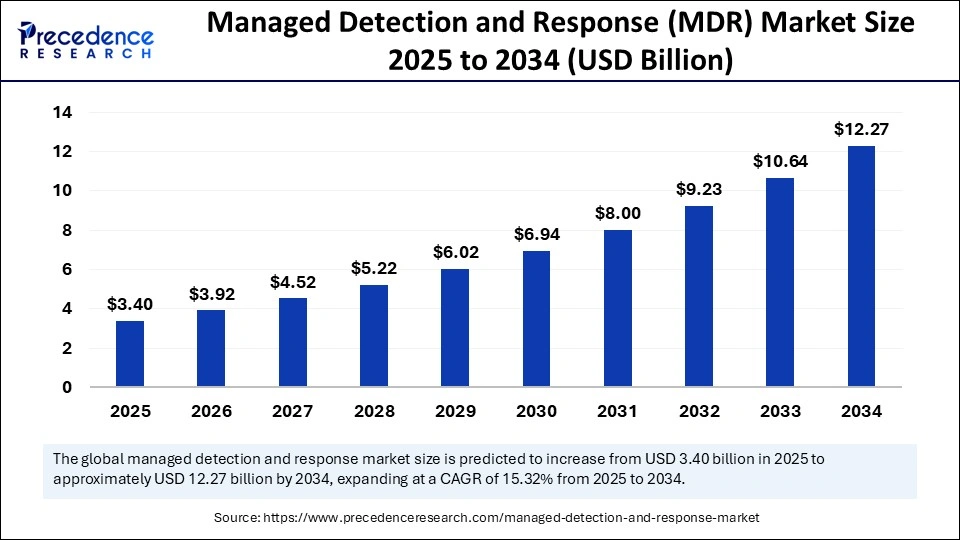
Managed Detection and Response (MDR) Market Key Takeaways
- North America dominated the global market with a largest market share of 46% in 2024.
- Asia Pacific is expected to witness the fastest growth in the coming years.
- By security type, the cloud detection and response segment led the market in 2024.
- By security type, the managed endpoint detection and response (MEDR) segment is expected to expand at the fastest growth during the forecast period.
- By deployment, the cloud-based segment contribute the biggest market share in 2024.
- By deployment, the on-premises segment is likely to grow rapidly during the projection period.
- By enterprise size, the SMEs segment held the largest share in 2024.
- By enterprise size, the large enterprises segment is expected to expand at the highest CAGR between 2025 and 2034.
- By vertical, the BFSI segment led the market with the largest share in 2024.
- By vertical, the IT & telecom segment is likely to witness the fastest growth in the upcoming period.
Market Overview
The managed detection and response (MDR) market is emerging as a critical component of modern cybersecurity strategies, providing organizations with real-time threat detection, response, and continuous monitoring services. MDR solutions are tailored for enterprises that lack the in-house capabilities or resources to build comprehensive security operations centers. The market is gaining traction across sectors including finance, healthcare, retail, and manufacturing, particularly as digital transformation efforts increase attack surfaces. MDR services integrate advanced threat intelligence, behavioral analysis, and security orchestration to deliver proactive defense and rapid incident response.
Drivers
The increasing complexity of cyber threats, particularly targeted attacks and ransomware, is driving the adoption of MDR services. Organizations are under growing pressure to meet stringent regulatory compliance requirements such as GDPR, HIPAA, and CCPA, which necessitate continuous monitoring and incident response capabilities. The rising frequency of data breaches and the shortage of skilled cybersecurity professionals are further accelerating demand. Additionally, the adoption of hybrid work environments and cloud infrastructures is creating new vulnerabilities that MDR providers are well-positioned to manage.
Opportunities
There are considerable opportunities for MDR providers to expand their offerings through AI and machine learning integration, which can enhance anomaly detection and automate incident triage. As small and medium-sized enterprises become more cyber-aware, demand for cost-effective and scalable MDR solutions is expected to rise. Opportunities also exist in vertical-specific MDR services tailored to the unique threat landscapes of industries such as banking, healthcare, and critical infrastructure. Moreover, the development of MDR-as-a-service platforms that provide customizable modules will appeal to organizations looking for flexible cybersecurity solutions.
Challenges
Despite its growth potential, the MDR market faces challenges related to market differentiation and vendor trust. With many players offering similar core features, establishing unique value propositions becomes difficult. There is also a challenge in balancing automation with the human expertise required for contextual threat analysis and response. In addition, integrating MDR solutions with legacy IT systems can be complex and costly, particularly for organizations with fragmented infrastructure. Concerns about data privacy and control when outsourcing cybersecurity services continue to hinder adoption in regulated industries.
Regional Insights
North America dominates the MDR market, driven by high cyber threat exposure and early adoption of managed security services. The region benefits from a mature cybersecurity ecosystem and regulatory compliance culture. Europe is seeing accelerated growth due to increasing government initiatives on data protection and critical infrastructure security. Asia-Pacific is an emerging hotspot, with countries like India, China, and Japan investing in advanced cybersecurity frameworks and experiencing a rise in cyberattacks. Latin America and the Middle East are gradually adopting MDR solutions, focusing on financial services and government sectors.
Recent Developments
Recent developments in the MDR market include strategic partnerships between MDR vendors and cloud service providers to offer integrated protection for multi-cloud environments. Several providers are enhancing their platforms with automated incident response and playbook features. Leading MDR companies are acquiring threat intelligence firms to bolster their analytics capabilities. Additionally, industry alliances are forming to establish standardized MDR service models and promote interoperability between security tools and platforms.
Managed Detection and Response (MDR) Market Companies
- Accenture
- Arctic Wolf Networks Inc.
- CrowdStrike
- Deepwatch
- FORESCOUT
- Fortra, LLC
- LMNTRIX
- Rapid7
- Red Canary
- Secureworks
Segments Covered in the Report
By Security Type
- Managed Endpoint Detection And Response (MEDR)
- Managed Network Detection And Response (MNDR)
- Cloud Detection And Response
- Others
By Deployment
- Cloud-based
- On-premises
By Enterprise Size
- SMEs
- Large Enterprises
By Vertical
- BFSI
- Retail
- IT & Telecom
- Healthcare
- Manufacturing
- Government & Defense
- Others
By Region
- North America
- Europe
- Asia Pacific
- Middle East & Africa
- Latin America